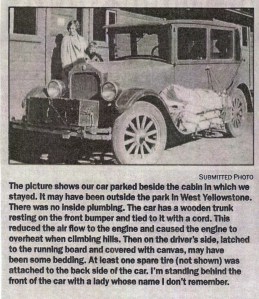Posted with permission from the author, Paul Massier.
I remember some of the events of a trip that my parents and family took to Yellowstone National Park from Pocatello in our 1926 Star automobile. Based on dates written under pictures in the family album, I’m quite certain that it was in the summer of 1928. I was 5 years old. Perhaps I’m wrong, but I think that along this route there was no real highway at this time. Instead, there were simply stretches of dirt and gravel roads between towns with some type of paving in a few towns.
This trip was taken together with another family in their car so that there were two autos that traveled together. In case of a breakdown, the two families could render assistance to each other. The most common breakdowns in those days were caused by flat tires and overheated engines. My oldest brother, Johnny, drove our car. Most of the time the two cars kept a considerable distance between them while traveling in order to avoid as much dust as possible, generated by the lead car, from engulfing the follower. The rear car generated dust also and even this made it uncomfortable for its passengers. But at times those in the rear car did follow close enough so that one could see nothing but dust through the front window. I remember sitting in the back seat beside a window. If the window was rolled up, it would get hot and stuffy inside. If I rolled it down, the road dust blew inside.
Whenever we came to a paved surface, I rolled the window down to get some fresh air.
The maximum safe driving speed on any of these gravel roads was about 35 miles per hour. Along most stretches, we were able to go at that speed and occasionally my brother pushed it to 40. The distance from Pocatello to Yellowstone was about 175 miles, a full day’s drive at that time with at least one planned stop for a picnic lunch along the way. Along some stretches the railroad tracks were within viewing distance and that was a guide in maintaining the proper course to our destination. I don’t recall noticing whether we had a road map, but we did stop at some service stations to inquire which road to take out-of-town and what the road conditions were like ahead.
Gas stations were real service stations at that time. The attendant not only put gasoline in the tank, he cleaned the windows, checked the oil level, checked the level of the water in the radiator and added water if necessary. If asked to do so, he also checked the level of the water in the battery and the air pressure in the tires, all as part of the service. In addition, he repaired flat tires for a fee.
I think the self-service to fill the gas tank was not even permitted. Most of the time we didn’t fill the gas tank, but instead, just purchased a certain number of gallons. Restrooms in most places were outhouses.
Along some stretches of the road where there had been recent rains, ruts several inches deep had been formed by tires of automobiles that had passed there recently when the surface was muddy. Since these ruts were generally right in the middle of the lane, one or both wheels tended to get “stuck” in them and follow them as they zigzagged around. It sometimes required a considerable force applied to the steering wheel to maneuver out of them. The road along some stretches in remote areas were very narrow and whenever we were approaching a “blind” curve, Johnny would honk the horn to warn oncoming cars. We probably spent a couple of days inside the park before returning home. The only sights I remember seeing were a few bears, Old Faithful geyser, Morning Glory pool and the Mud Pots.
Mr. Massier’s story was published in the Sunday edition of the Idaho State Journal, November 14, 2010. I phoned him that morning after I read his essay and asked if I could post it in our blog. What an awesome account of what it was like to travel when my grandparents were running the family business, our own Rankin Auto Court. The cabins are still on the property and we’re still welcoming visitors traveling to Yellowstone Park. I do believe the roads are in a little bit better shape though service stations are truly things of the past. Thank you Mr. Massier for visiting with me on the phone and for allowing us to post your account!



Leave a Reply